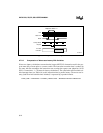
6-13
INTERRUPT SYSTEM
6.7.2.3 Latency Calculations
Assume the use of a zero-wait-state external memory where current instructions, the ISR, and the
stack are located within the same 64-Kbyte memory region (compatible with memory maps for
MCS 51 microcontrollers.) Further, assume there are 3 states yet to complete in the current 21-
state DIV instruction when INT0# requests service. Also assume INT0# has made the request one
state prior to the sample state (as in Figure 6-7). Unlike in Figure 6-7, the response time for this
assumption is three state times as the current instruction completes in time for the branch to occur.
Latency calculations begin with the minimum fixed latency of 16 states. From Table 6-6, one state
is added for an INT0# request from external hardware; two states are added for external execu-
tion; and four states for an external stack in the current 64-Kbyte region. Finally, three states are
added for the current instruction to complete. The actual latency is 26 states. Worst-case latency
calculations predict 43 states for this example due to inclusion of total DIV instruction time (less
one state).
Table 6-6. Interrupt Latency Variables
Variable
INT0#,
INT1#,
T2EX
External
Execution
Page
Mode
>64K
Jump to
ISR (1)
External
Memory
Wait
State
External
Stack
<64K (1)
External
Stack
>64K (1)
External
Stack
Wait State
Number
of
States
Added
1218
1 per
bus cycle
48
1 per
bus cycle
NOTES:
1. <64K/>64K means inside/outside the 64-Kbyte memory region where code is executing.
2. Base-case fixed time is 16 states and assumes:
— A 2-byte instruction is the first ISR byte. — Internal execution
— <64K jump to ISR — Internal stack
— Internal peripheral interrupt
Table 6-7. Actual vs. Predicted Latency Calculations
Latency Factors Actual Predicted
Base Case Minimum Fixed Time 16 16
INT0# External Request 1 1
External Execution 2 2
<64K Byte Stack Location 4 4
Execution Time for Current DIV Instruction 3 20
TOTAL 26 43


















